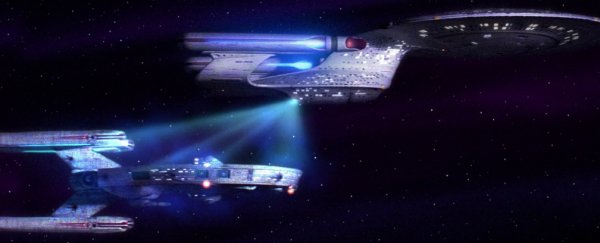NASA has announced that it's partnering with Arx Pax, a company that unveiled a semi-functional hoverboard at the end of last year. They'll be working together to build a device that can attract objects from a distance in space.
According to Arx Pax, the primary intention will be to create a type of specialised magnetic field that helps satellites stick together and move in a coordinated way. But we're not the only ones who have clued onto the fact that they're essentially building a real-life tractor beam (albeit a small one).
While Arx Pax's Hendo Hoverboard got plenty of media attention when it was announced back in November, it was really just a launchpad to showcase their special 'Magnetic Field Architecture (MFA)'. What that means is that they've managed to create magnetic fields that can levitate an object up off a special metallic surface below.
"The Hendo Hoverboard was on some levels a success, but it was no Back to the Future," writes Maddie Stone for Gizmodo. "The thing only worked on a special metallic surface, it made loud, screechy noises, and its battery life was pretty bad." Not ideal.
But since then Arx Pax has been hinting at lots of other exciting uses for MFA technology, including building levitating homes that can survive earthquakes. And now, apparently, they're also going to use their magnetic fields to control objects in space.
"Arx Pax and NASA will work together to design a device with the ability to attract one object to another from a distance," a press release explains. "The device will draw as well as repel satellites at the same time, meaning it will hold a satellite at a distance and won't allow it to move away or toward the capture device. This will enable the capability to capture and possibly manipulate micro-satellites or other objects without making physical contact with them."
What's the point of all of this? Being able to coordinate and link up satellites could have some pretty big benefits for Earth's monitoring systems, as well as space exploration. In fact, Arx Pax Founder and CFO Greg Henderson told Gizmodo that the focus will be on CubeSats - the tiny satellites that NASA hopes to one day send to distant planets.
"NASA realised that this is a fundamental tool," Henderson told Gizmodo. "What we're providing NASA is a way of manipulating objects in space without touching them."
The MFA technology works by using electromagnetic energy to produce a magnetic field, which then induces an opposing magnetic field in the material below it. These two magnetic fields repeal each other, making the source of the electromagnetic energy - the 'hover engine', as Arx Pax calls it - levitate slightly. These same interacting magnetic fields can also be used to attract objects.
While it's still a long way off the tractor beams used in Star Trek and the Star Wars films to draw in enemy spacecraft, it's also pretty exciting that this technology is being embraced and developed by NASA. We can't help but hope that it'll one day be used to help beam human technology to distant worlds.
